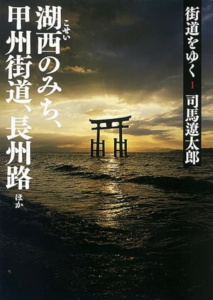Life Tips & Miscellaneous Travel and History Zen Philosophy and History Art and Sport Navigation of this blog
Summary
Travel is an act for human beings to visit new places and experience different cultures and histories. Through travel, people can actually feel historical events and people’s lives by visiting historical places and cultural heritage sites, and can gain a deeper understanding of history and broaden their own perspectives. In this section, we will discuss the historical background of the trip and the places visited based on Ryotaro Shiba’s “Kaido yuku” (On the Road) about this journey and history.

Kaido yuku” (On the Road) began in 1971 as a serialization in “Asahi Weekly” and continued for 25 years until Ryotaro Shiba‘s death in 1996, making it a total of 43 volumes. From the first volume, I would like to describe the Kosai-no-michi.
Roads, History and Ironman Races in Kosai
The Kosai-no-michi starts from the east side of Kyoto (the area around Nanzenji Temple, which is a separate temple from the five mountains of Kyoto, as opposed to the five mountains of Kamakura, in “Zen, Temples, and the History of Kamakura (Rinzai Zen and the Five Mountains of Kamakura)” and heads toward the Otsu area.

First, we will start with Mitsui Temple‘s Shilla Zenjindo (Hoshi Chuo), which tells the story of the relationship between ancient Japan and the Korean Peninsula and Shilla. Mitsui Temple (Enjoji Temple) is also famous for its cherry blossoms.

Then, passing through the foot of Mt. Hiei, where Enryaku-ji Temple was founded by Saicho and where Dogen, also mentioned in “Zen Master Dogen,” practiced Buddhism.

Further north along Lake Biwa, we headed for Shirahige Shrine, which stands along Lake Biwa and is the story of a civil engineering group called the Anata no Kurohoe of Omi.


From there, we go a little north to the town of Azumigawa, where we proceed to the story of an ancient tribe called the Azumi-jin (people of southern descent who also existed in Azumino and other areas in Shinshu?) The story proceeds to the Azumigami people. The main character of “Inui to Tatsumi – Zabaikaru Senki” serialized in Kodansha’s monthly magazine “Afternoon” by Yoshikazu Yasuhiko, the famous author of “Mobile Suit Gundam,” is a descendant of the Azumis.

Next, from Azumigawa Town, head along the Azumigawa River to Kutsuki Village, which is at the intersection with National Route 367 (Saba Highway).

On the Kutsuki Kaido (Saba Kaido), we proceed to the story of Nobunaga‘s great retreat due to the treachery of Asakura in Omi during his attack on Asakura in Echizen. This Saba Kaido is also the (only) bus route from Fukui Prefecture on the Sea of Japan side to Kyoto/Osaka, which often appears in the now nationally popular program “Local Route Connection Trip“.
The road trip ends with a visit to Kosei-ji Temple and a visit to the former Shuteninji Temple Garden, created by the second shogun, Ashikaga Yoshiharu, to discuss the sorrows of the Muromachi Shogunate shoguns.
Lake Biwa is also the site where Japan’s oldest triathlon, the Ironman race, started in 1985 as described in “Triathlon, Hawaii Island and Ironman” (the Ironman race on Lake Biwa ended in 1997).

The swim course was 3.9Km, which took place at the Matsubara Swimming Beach (lower star) overlooking Hikone Castle, and involved swimming in the lake water. The run was 42.195 km, using the lakeshore road through the Oku-Biwa Sports Forest (middle star) and Nagahama City.

Maibara in the east of the lake is located between Kyoto and Nagoya, where the Shinkansen bullet train connects Nagoya → Gifu Hashima → Maibara → Kyoto, and is also a transfer station for Hokuriku area such as Fukui/Kanazawa, but it is a remote area where no local bus service is available and people often DNF on the aforementioned bus trip, making it the perfect location for the triathlon.
In the next article, we will discuss the Takeuchi Kaido.


コメント